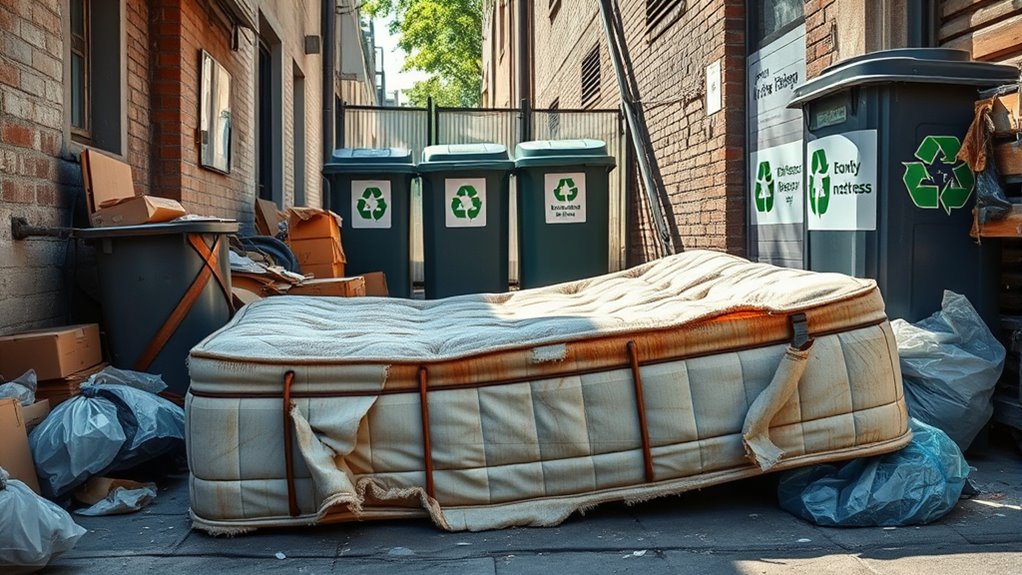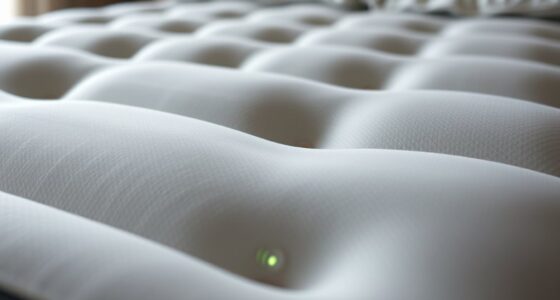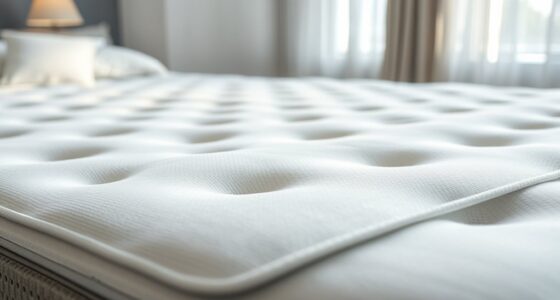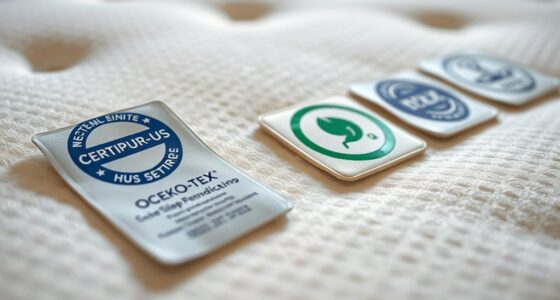To dispose of or recycle an old mattress, first identify its materials—like metal coils or foam—as this affects recycling options. Check if your community offers mattress recycling programs or take it to a dedicated recycling center that dismantles and separates components for reuse. Your local charities may accept gently used mattresses for donation. For other types, professional disposal services can handle the process responsibly. If you’d like to explore more eco-friendly methods, keep exploring your options.
Key Takeaways
- Identify your mattress type (innerspring, memory foam, latex, hybrid) to determine suitable disposal or recycling methods.
- Contact local recycling centers or mattress recycling programs for proper dismantling and material separation.
- Consider donating gently used mattresses to charities or shelters, following their acceptance policies.
- Use professional disposal services that partner with recycling facilities to ensure environmentally responsible handling.
- Remove bedding and accessories before disposal and inquire about special procedures if your mattress contains chemicals or synthetic materials.
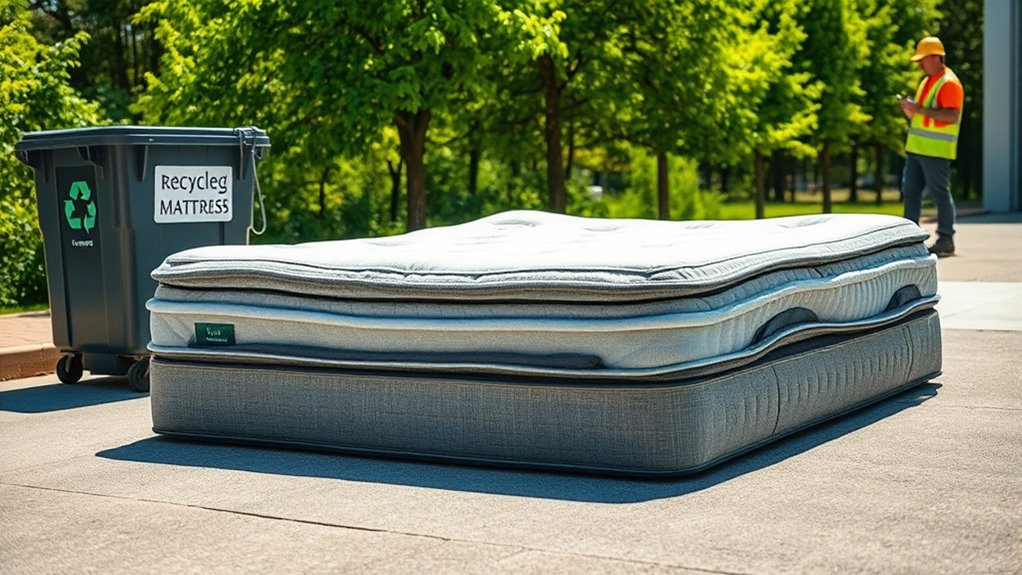
When it’s time to get rid of an old mattress, knowing your options for disposal or recycling can make the process easier and more environmentally friendly. Mattresses come in various types, including innerspring, memory foam, latex, and hybrid models. Each type has different materials, which can influence how you dispose of them. For instance, innerspring mattresses contain metal coils that can be recycled, while foam and latex models are made from different synthetic or natural materials that may require specific recycling processes. Recognizing your mattress type helps you choose the best disposal method and find the right recycling facilities that can handle those materials.
Recycling facilities play a vital role in reducing waste and keeping usable materials out of landfills. Many communities have dedicated recycling centers or special programs for mattresses. These centers often dismantle the mattress, separating metal springs, foam, fabric, and wood components. Metal coils are typically melted down and reused in manufacturing, while foam and fabric may be repurposed or shredded for other products. To find these facilities, check with your local waste management authority or search online for mattress recycling centers in your area. Some facilities even offer pickup services, making the process more convenient, especially if your mattress is bulky or difficult to transport.
Many communities offer mattress recycling centers that dismantle and repurpose materials, with pickup options available.
If your mattress is still in decent condition, donating it to charities or shelters is another responsible option. Many organizations accept gently used mattresses, but you’ll want to verify their policies first. When recycling isn’t feasible, and donation isn’t an option, consider professional disposal services. These services often partner with recycling facilities to guarantee your mattress is disposed of properly, minimizing environmental impact. Always remove bedding, pillows, and other accessories before disposal to streamline the process and guarantee the mattress is accepted.
Keep in mind that some mattress types, especially those with fire-retardant chemicals or certain synthetic materials, may require special handling. Always inquire if there are specific disposal instructions for your mattress type. Many recycling facilities are equipped to handle common mattress materials, but it’s essential to verify this beforehand to avoid complications. Additionally, choosing eco-friendly disposal options can further reduce environmental impact and support sustainability efforts.
Ultimately, understanding your mattress type and knowing where recycling facilities are located empowers you to dispose of your old mattress responsibly. It’s a small step that can considerably reduce waste and promote sustainability. Taking the time to research your options ensures you’re making an environmentally conscious choice while simplifying what can sometimes feel like a formidable task.
Frequently Asked Questions
Are There Any Costs Associated With Mattress Disposal Services?
When considering mattress disposal, you might wonder about the cost considerations. Service fees can vary depending on your chosen method, whether it’s a removal service, recycling program, or donation. Some disposal options are free, especially if you take the mattress to a recycling center yourself. However, professional pickup services often charge a fee to cover labor and transportation. Always check ahead to understand any associated costs before proceeding.
Can I Donate My Old Mattress Instead of Disposing of It?
Imagine your old mattress as a sleeping giant ready for a second adventure. You can donate it instead of tossing it away, but check donation guidelines first. Many mattress donation centers accept gently used mattresses, especially twin or full sizes. Make certain your mattress is clean and in good condition. Contact local centers to confirm their policies, and give your mattress a new purpose—helping someone rest easier.
How Long Does the Recycling Process Take?
The recycling timeline and processing duration for an old mattress can vary depending on the facility. Typically, it takes around 2 to 4 weeks for the entire process, including collection, transportation, and recycling. You might experience some delays if the facility is busy or if your mattress needs special handling. Staying in contact with the recycling center can help you get updates on the processing duration and expected completion.
Are There Environmentally Friendly Disposal Options Available?
Imagine a world where your old mattress transforms into new materials, reducing waste and pollution. You can choose eco-friendly methods like donation, repurposing, or using specialized recycling programs that prioritize sustainable disposal. These options help protect the environment by minimizing landfill waste and conserving resources. By selecting sustainable disposal, you’re actively contributing to a healthier planet, turning what was once discarded into valuable resources for future use.
What Should I Do if My Mattress Has Bed Bugs?
If your mattress has bed bugs, start with a thorough mattress inspection to confirm the infestation. Then, consider professional bed bug treatment options to eliminate them effectively. You might need to clean your bedding and surrounding areas as well. If the infestation is severe, replacing the mattress could be necessary. Always follow expert advice to guarantee complete removal and prevent future issues.
Conclusion
When it’s time to say goodbye to your old mattress, remember that disposal or recycling isn’t a formidable mountain but a manageable hill you can climb. By choosing the right method, you’re giving your mattress a second chance to serve a new purpose—like a phoenix rising from the ashes. Your efforts help reduce waste and protect the environment, making the process worthwhile. So, take action today and turn your mattress’s end into a new beginning.
